Less flower, more power. That’s the message Volkswagen hopes to get out as it prepares for the upcoming launch of the third-generation Volkswagen Beetle.
As unlikely as it might seem, that’s not a typo. Since the original “people’s car,” or Volkswagen, was introduced in the dark days before the Second World War, it has gone through any number of refinements, but only two complete updates. And the last time VW revealed a redesign it wound up with the New Beetle, an insufferably sweet “chick car” that largely alienated the male half of the automotive buying public.
Not so this time, as VW emphasized during a global launch, last April, and at this week’s first drive in Berlin. Along with the flower vase, the maker has abandoned the semi-circular shape of the New Beetle, the “21st Century Beetle” adopting what designers like to call a heritage design.
Sitting side-by-side in the German capital’s Potsdamer Platz, it’s easy to see the influence of the original Beetle, the longest-lived and best-selling car in global automotive history. The new model regains the classic silhouette, with its long, rounded snout and a lower, more aggressive roof-line. Aggressive is the active word, for VW, which believes the new edition can appeal to both men and women with its more sporty look.
And its improved functionality. The added length up front allows for a complete interior redesign that turns the 2012 Volkswagen Beetle into a functional four-seater with a surprising amount of cargo space. Meanwhile, the three engine options American motorists will get should appeal to a wide mix of needs and desires, whether the emphasis is on performance, fuel economy or a mix of both.
The third-generation Beetle unmistakably reveals the signature of Ferdinand Porsche, the legendary German behind both the original people’s car and later the sports car brand bearing his name. Were you to sit the 2012 Bug besides an early Porsche 911, the visual lineage would be unmistakable.
The new car isn’t just a remake of Ferry Porsche’s past glories, however. It’s a decidedly modern car, even though underlying cues of the first Porsche-designed Beetle, such as the upright windshield, are so apparent. Indeed, let’s be clear, up front. The era of the original Beetle, a car renowned for its simplicity, low price, and easy maintenance, is long gone.
The new 2012 Beetle is very much a modern car. It is loaded with new technology, from its bi-xenon headlamps with LED daytime running lights to the complement of airbags to its big navi screen and integrated infotainment system. You can be confident the water-cooled engines will heat the cabin and clear the windshield on a cold day, something that was always questionable with the original.
One thing the Volkswagen Group has gotten good at is distinguishing models that share the same platform. That was critical considering the foundation of the new Beetle is borrowed from the decidedly different Audi A5. At 168.4 inches, the 2012 Volkswagen Beetle is 6 inches longer than the unlamented New Beetle. It’s more than three inches wider, at 71.2 inches, but it’s also a half inch lower, at 58.5 inches. Surprisingly, headroom is better for both front and rear seat passengers, thanks to a complete interior redesign that moves the front seat forward, giving the car a more sporty, cockpit-like feel.
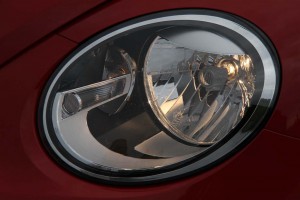
The look may be familiar but it's a very modern remake, underscored by details like the b-xenon headlights with LED running lights.
The lower roofline is complimented by decidedly larger tires – up to 19 inches on the Turbo Sport package. The Turbo also gets a rear spoiler. So did the New Beetle’s turbo edition, but where that version looked almost toy-like, the 2012 model has a decidedly sporty feel.
Despite sitting closer to the windshield, there’s nothing claustrophobic about the new car’s cabin. For driver, gauges are easy to read, controls are readily within reach – including the paddle shifters that will come on the American version of the turbo. Considering the U.S. base price of $19,765 (including $770 in delivery charges), buyers will find a car that is unexpectedly well-executed, almost Audi-like in terms of refinement.
The navigation system is a first for VW, incidentally. Sadly, while the maker insists it wants to make the technology affordable, it will be a costly option as it’s available only in a package loaded up with other popular techno features. Also new on the 2012 Beetle is a Fender premium sound system.
Yes, that Fender, the company best known for its rock-n-roll guitars and amps has partnered with Panasonic and VW to come up with a custom-tailored, 400-watt audio system with 8 speakers and a massive subwoofer that, unfortunately, does eat up a bit of trunk space.
Another option we expect will be in high demand is the new sunroof that can open to a full 11 inches – enough that VW engineers had to come up with a system that automatically closes the sunroof part way when you open the trunk.
Fans of the original, Spartan metal Beetle interior would likely not even recognize the 2012 offering but for the addition of the kaeferfach, or Beetle bin, a second, small glovebox mounted just above the main, downward-opening box.
Turning to the Audi-derived platform, the newest Beetle rides on a multi-link independent rear suspension with telescopic dampers and an 18-millimeter anti-roll bar. Up front, the car gets a new strut-type suspension with lower control arm and a 22 mm anti-roll bar on the base car – it grows to 23 mm on the Turbo edition.
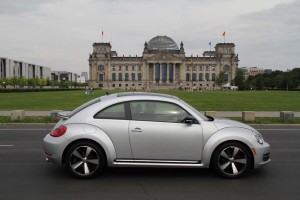
The U.S. version of the Turbo, shown here by the German Reichstag, will get paddle shifters and a Start button, among other details.
The Turbo was the only engine available during our Berlin visit, even though it’s expected to represent just 13% of eventual U.S. sales. The 2.0T is, as that suggests, a 2.0-liter inline-four making 200 horsepower, plenty for a package like this. Power comes on quickly, with only a modicum of torque steer and wheel spin under the most aggressive launches.
Like the rest of the powertrain line-up – which will ultimately include a 170-hp 2.5-liter I5 and a 140-hp 2.0-liter turbodiesel – the transmission of choice is a new 6-speed DSG, a dual-clutch automatic. The alternatives are a 5-speed stick on the base I5 and a 6-speed manual on the 2.0T.
Initially, we were disappointed by the DSG, which seemed sluggish to shift. Like many makers, VW has apparently programmed the gearbox to default to high-mileage mode. But it uses software smart enough to learn what the driver is demanding and respond accordingly. So, after an hour or so behind the wheel it seemed almost like we were driving an entirely different car.
The wider platform is a definite plus for those who enjoy sport driving and it only takes a few minutes to realize how much better the 2012 Beetle is than the old car. But while the powertrain and suspension might largely be derived from the Volkswagen GTI, the 2012 Beetle is nowhere near as well-planted. True, it handles corners comfortably and confidently – with the 2.0T’s GTI-derived seats keeping you firmly in place – but the 2012 Beetle just doesn’t have quite the overall level of composure.
Our one real complaint arose during the first part of a long trip out from Berlin and into the German countryside. On the first stretch of road we experienced a bit of that unsettling road hop you often run into on California freeways. It didn’t last long and didn’t repeat, so we’ll cautiously chalk it up to flawed pavement rather than the Beetle’s suspension.
The reality is that barring any significant technical flaws, the 2012 Volkswagen Beetle would be sold on looks rather than performance. It’s got that natural, retro appeal for older drivers while younger motorists will find it sporty and distinctive – rather than cute, like the New Beetle.
The New Beetle, when it debuted, was generating as much as 83,000 sales annually in the U.S. alone – though volumes slipped by a staggering 80% before the car was finally retired. The maker isn’t offering official sales projections for the 2012 model but Volkswagen officials don’t hide their high hopes for the third-generation Bug.
While it isn’t expected to quite match the volumes of the big Passat or more mainstream Jetta, the Beetle is, in the words of marketing chief Rainer Michel, “the emotional center of the brand.” That should translate into a halo for a brand desperate to regain the once-lofty position it held in the American market.
Significantly, VW plans to launch the Beetle in the U.S. market first, starting in October, with Europe and the rest of the world to follow.
Based on our initial drive we expect to see a lot of folks lining up to place their orders. And if the base and turbodiesel models match up with the 2.0T, we anticipate demand will hold up a lot better, in the years to come, than it did for the oh-too-cute New Beetle.

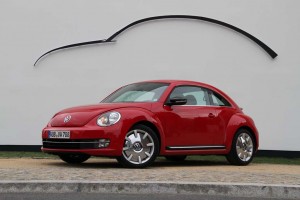
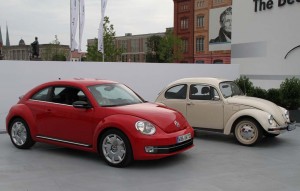
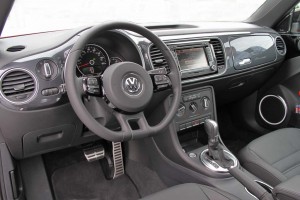
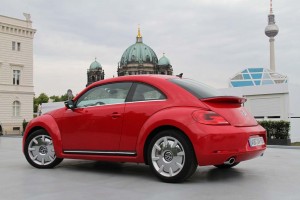
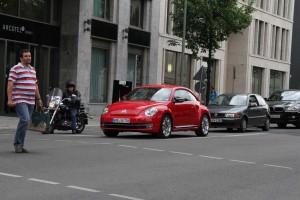
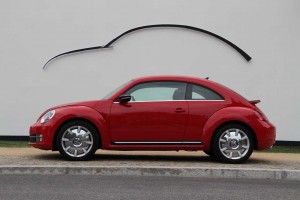
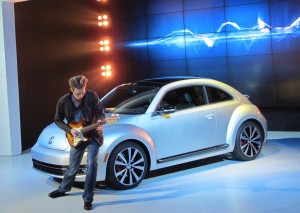
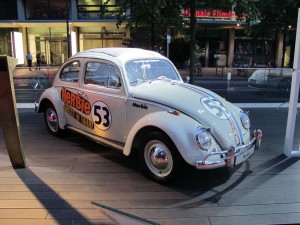
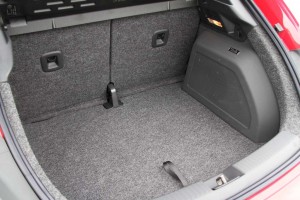
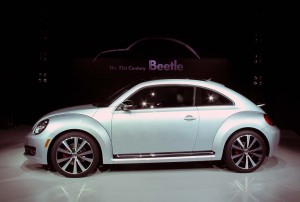
Thank you for such a great review. It will likely not be matched by the clueless mainstream automotive press. But I differ, as a former owner of an origial 912, lover of the original Beetle, and former owner of two New Beetles. I currently drive a 2005 E-class and find the new one’s chiseled looks disappointing and less “classic” than it should be.
Yes, the New Beetle was considered “feminine,” but only after our culture, especially in cars, became more and more “hyper-masculinized.” Even rock groups lost the colorful clothing and long hair of the ’70’s when masculine jeans, dark dull colors, and male gruff voices became “de-rigeur” for even female lead vocalists since the ’90’s. I dare you to find a male with any white car with tan interior who isn’t considered “gay” any more, or one with any convertible for that matter! I consider this to be rampant homophobia and major insecurity in masculinity in our screwed up culture! Many European males are not this way and would feel very comfortable in their Fiat 500’s, Mercedes SLK’s, and VW anythings. But American males are traditionally insecure about their masculinity, so we need our V8’s, V10’s, black/grey/uh nothing else… to show we are not, uh, at all feminine!
The New Beetle DID start off as unisex but became a chick car over the years because of our culture changing. But cars have always traditionally been feminine, just like boats and airplanes. This should not have changed. I resent the lack of choice this presents and the teasing it creates.
I found your reference to the original 911 very refreshing and hopeful. Maybe the artistic sense will come back to car choice and we won’t let just hormonal insecurity make the choices for us! I find the pictures of the extra large wheels made to look nasty rather ugly. Might as well get a Tonka truck eventually! Looking at the newest BMW 5 series is a great example – its a total blob of nothing! VW designers may be aware of this, I’m sure, but may have found a happy medium. We shall see if the standard wheels look artistic and complement the car with mature grace.
Cheers
Oh, and if they didn’t want a girley image, they should have passed on having Oprah give away a Beetle recently!
As far as simplicity, take one look at http://www.tdiclub.com and see how much easier it is to service any VW compared to other German makes! I would not be afraid to do a lot of it, save for some internal engine work and suspension, myself.
Gen,
Thanks for the kinds words. And for an interesting take on the issue of the Beetle’s appeal. There’s long been a debate about who to and how to appeal with automotive design, and in decade’s past makers have occasionally tried cars aimed at the distaff side, even providing a seat in one model, back in the ’60s, that swiveled to make it easier for a woman in a skirt to get in and out.
For some vehicles, the image of being a “chick car” has been devastating to sales. For others not so much. Curiously, the Mustang’s V-6 version was long seen as a “secretary’s car,” another way of saying a poseur, though today, with a serious 300 hp engine I don’t hear that reference made much anymore. But even when it was been so derided, “real men” didn’t seem to have trouble being seen in the GT. One very valuable two-letter badge, apparently.
It’s not just a car perceived as feminine that has trouble, of course. The old adage is that you can sell an old man on a young man’s car but not the other way around.
But back to the Beetle, it has been interesting to talk to “civilians” who neither write about nor work in the auto industry, to get their reaction to the New Beetle. I haven’t quite determined whether they perceive it to be more masculine on their own or have simply heard it said enough that they internalize that interpretation. We’ll see if that translates into a stronger demand for the new, not-New, Beetle.
Paul A. Eisenstein
Publisher, TheDetroitBureau.com
I agree Gen it’s a shame that the New Beetle was perceived by many men as feminized. And I agree, with notable exception men do gravitate to edgier design themes, increased horsepower more demanding handling characteristics. Possibly a reflection of the lack of feminine participation in motorsport, mores the pity. At the risk of being perceived as homophobic, which I am not, the New Beetle was presented as an attractive feminine vehicle. How many men after a walk around of this delightful underpowered little car, saw the factory installed vase and single flower featured prominently on the dashboard said to themselves and others, “This is a vehicle I would enjoy being seem in”… Not many. I know a few European friends who felt the same way.
The original and new mini designs are other examples of a delightful little automobiles embraced by women, a good thing. These same models were upgraded immediately as the Cooper and Cooper S with a racing series both road and alpine and a whole new marketing segment opened. I would suggest to you and Volkswagen that if you choose to shake off a perceived unfair feminine image associated with this New Beetle, introduce the muscle and might of the lineage of Porsche, race it and win. I can guarantee a greater portion of a missing marketing segment. To suggest men who disagree with this very pretty design concept and other seemingly feminine designs are homophobic is unfair.
Hi, Mike,
Short of getting into those classic Freudian debates over men’s fears, homosexuality and homophobia, I won’t buy in that a distaste for “feminine” design is really just homophobia at work.
By the way, I DO wonder, in hindsight exactly what some VW planners and marketers had in mind with the vase and related marketing on the New Beetle. I actually do NOT believe the intentionwas to feminize the vehicle but to Truro connect with it’s Hippie heyday. But things got, as they say, “lost in translation.”
A favorite memory was the official launch of the New Beetle at one of the old ’60s-era clubs in Atlanta, which was made up in a Germanic interpretation of Haight Ashbury. Most execs tried to pick up on the theme. In the case of then-CEO Piech he showed up in his suit BUT with a big peace sign pinned to it…UPSIDE-DOWN.
Paul E.
MikeB: its not so much that getting a New Beetle gives one a personal image that plays into a personal homophobia. My view is that society itself has this “built in,” especially when I observe how people’s choice of cars is being made.
When the Miata came out, any number of very large, grisly males couldn’t keep their hands off one. Now, you can’t find one behind a wheel, and there are examples of similar cars: 356 cabriolet’s were once thought to be great cars by men, now they are a great “wife’s car” while the man gets a souped up 911 coupe, and forget a Boxster because that’s a chick car! Nonsense! Why do men need the extra power!? Are they so insecure in their masulinity?! Its not really “performance” is it?? I can get a great handling 914 2.0 or a great 318is and make mince meat out of older Corvettes on country roads. I don’t need a phallus replacement strategy made popular by ‘Vettes with “300 horse” under the hood… not really very sporty, just phallic.
The comment about Mustang V6 cars is the same. 300 hp isn’t enough. One needs the label to make sure people know you are not in a “girlie” car by getting the “manly” V8 and the label GT or better!
Sorry, but a society that is so certainly slanted in its bias when in the past “true sports cars” were never that way is not well, IMO, and certainly not present in cultures that have less insecurity about their masculinity. Whether its from homophobia or anti-femininity, or something else, its shallow, arbitrary and not very “sporting” if you ask me.
Cheers.